
Gilles Pison, Muséum national d’histoire naturelle (MNHN) – Sorbonne Universités
The proportion of immigrants varies considerably from one country to another. In some, it exceeds half the population, while in others it is below 0.1%. Which countries have the most immigrants? Where do they come from? How are they distributed across the world? We provide here an overview of the number and share of immigrants in different countries around the world.
According to the United Nations, the United States has the highest number of immigrants (foreign-born individuals), with 48 million in 2015, five times more than in Saudi Arabia (11 million) and six times more than in Canada (7.6 million) (figure below). However, in proportion to their population size, these two countries have significantly more immigrants: 34% and 21%, respectively, versus 15% in the United States.
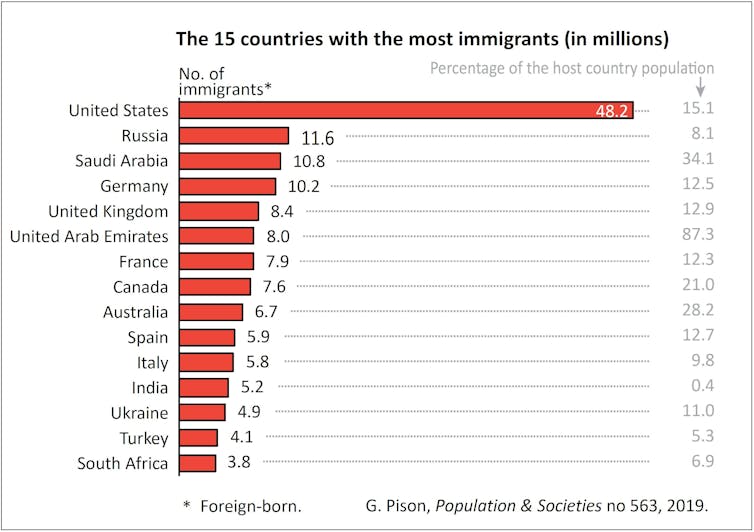
Looking at the ratio of immigrants to the total population (figure below), countries with a high proportion of immigrants can be divided into five groups:
- The first group comprises countries that are sparsely populated but have abundant oil resources, where immigrants sometimes outnumber the native-born population. In 2015, the world’s highest proportions of immigrants were found in this group: United Arab Emirates (87%), Kuwait (73%), Qatar (68%), Saudi Arabia, Bahrain, and Oman, where the proportion ranges from 34% to 51%.
- The second group consists of very small territories, microstates, often with special tax rules: Macao (57%), Monaco (55%), and Singapore (46%).
- The third group is made up of nations formerly designated as “new countries”, which cover vast territories but are still sparsely populated: Australia (28%) and Canada (21%).
- The fourth group, which is similar to the third in terms of mode of development, is that of Western industrial democracies, in which the proportion of immigrants generally ranges from 9% to 17%: Austria (17%), Sweden (16%), United States (15%), United Kingdom (13%), Spain (13%), Germany (12%), France (12%), the Netherlands (12%), Belgium (11%), and Italy (10%).
- The fifth group includes the so-called “countries of first asylum”, which receive massive flows of refugees due to conflicts in a neighbouring country. For example, at the end of 2015, more than one million Syrian and Iraqi refugees were living in Lebanon, representing the equivalent of 20% of its population, and around 400,000 refugees from Sudan were living in Chad (3% of its population).
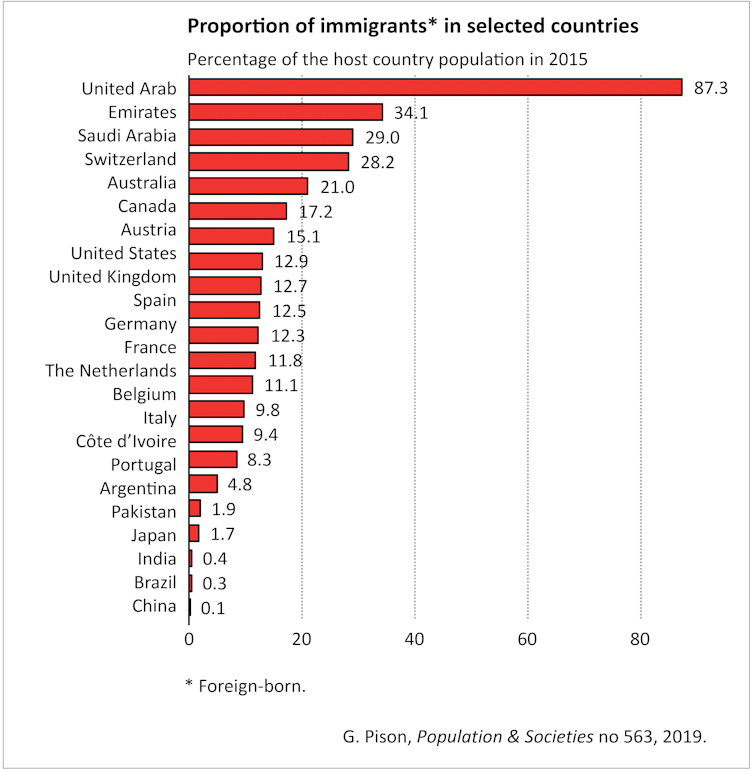
Small countries have higher proportions of immigrants
With 29% immigrants, Switzerland is ahead of the United States, while the proportion in Luxembourg is even higher (46%). Both the attractiveness and size of the country play a role. The smaller the country, the higher its probable proportion of foreign-born residents. Conversely, the larger the country, the smaller this proportion is likely to be. In 2015, India had 0.4% of immigrants and China 0.07%.
However, if each Chinese province were an independent country – a dozen provinces have more than 50 million inhabitants, and three of them (Guangdong, Shandong, and Henan) have about 100 million – the proportion of immigrants would be much higher, given that migration from province to province, which has increased in scale over recent years, would be counted as international and not internal migration. Conversely, if the European Union formed a single country, the share of immigrants would decrease considerably, since citizens of one EU country living in another would no longer be counted. The relative scale of the two types of migration – internal and international – is thus strongly linked to the way the territory is divided into separate nations.
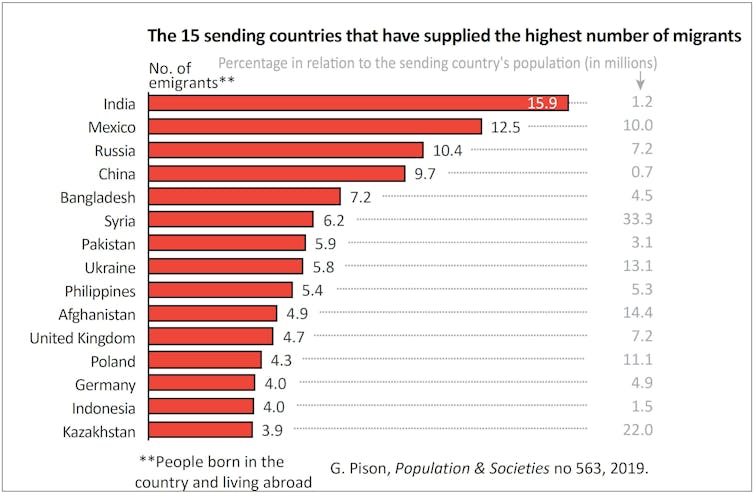
The number of emigrants is difficult to measure
All immigrants (in-migrants) are also emigrants (out-migrants) from their home countries. Yet the information available for counting emigrants at the level of a particular country is often of poorer quality than for the immigrants, even though, at the global level, they represent the same set of people. Countries are probably less concerned about counting their emigrants than their immigrants, given that the former, unlike the latter, are no longer residents and do not use government-funded public services or infrastructure.
However, emigrants often contribute substantially to the economy of their home countries by sending back money and in some cases, they still have the right to vote, which is a good reason for sending countries to track their emigrant population more effectively. The statistical sources are another reason for the poor quality of data on emigrants. Migrant arrivals are better recorded than departures, and the number of emigrants is often estimated based on immigrant statistics in the different host countries.
The number of emigrants varies considerably from one country to another. India headed the list in 2015, with nearly 16 million people born in the country but living in another (see the figure below); Mexico comes in second with more than 12 million emigrants living mainly in the United States.
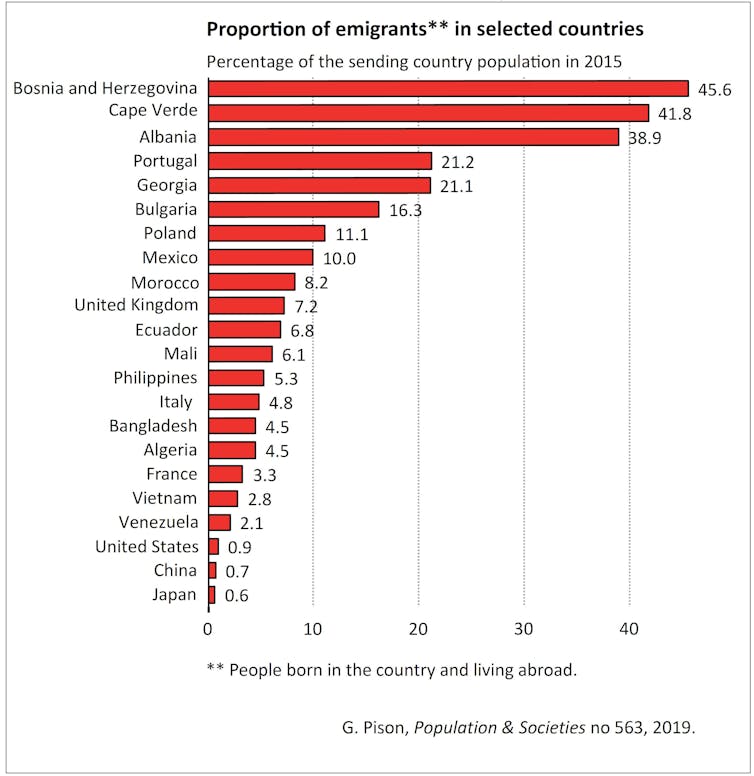
Proportionally, Bosnia and Herzegovina holds a record: there is one Bosnian living abroad for two living in the country, which means that one-third of the people born in Bosnia and Herzegovina have emigrated (figure below). Albania is in a similar situation, as well as Cape Verde, an insular country with few natural resources.
Some countries are both immigration and emigration countries. This is the case of the United Kingdom, which had 8.4 million immigrants and 4.7 million emigrants in 2015. The United States has a considerable number of expatriates (2.9 million in 2015), but this is 17 times less in comparison to the number of immigrants (48 million at the same date).
Until recently, some countries have been relatively closed to migration, both inward and outward. This is the case for Japan, which has few immigrants (only 1.7% of its population in 2015) and few emigrants (0.6%).
Immigrants: less than 4% of the world population
According to the United Nations, there were 258 million immigrants in 2017, representing only a small minority of the world population (3.4%); the vast majority of people live in their country of birth. The proportion of immigrants has only slightly increased over recent decades (30 years ago, in 1990, it was 2.9%, and 55 years ago, in 1965, it was 2.3%). It has probably changed only slightly in 100 years.
But the distribution of immigrants is different than it was a century ago. One change is, in the words of Alfred Sauvy, the “reversal of migratory flows” between North and South, with a considerable share of international migrants now coming from Southern countries.
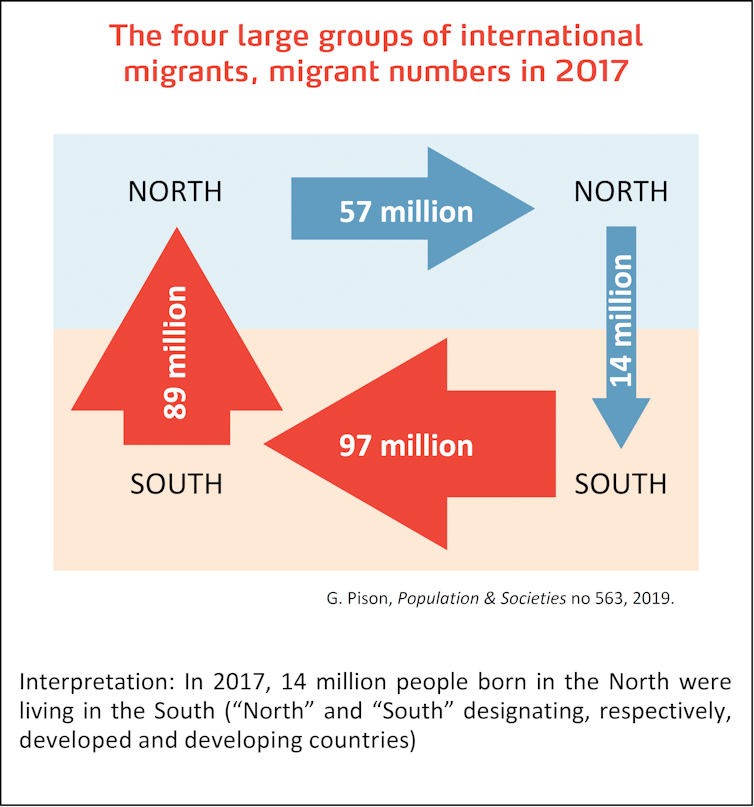
Today, migrants can be divided into three groups of practically equal size (figure above): migrants born in the South who live in the North (89 million in 2017, according to the United Nations); South-South migrants (97 million), who have migrated from one Southern country to another; and North-North migrants (57 million). The fourth group – those born in the North and who have migrated to the South – was dominant a century ago but is numerically much smaller today (14 million). Despite their large scale, especially in Europe, migrant flows generated since 2015 by conflicts in the Middle East have not significantly changed the global picture of international migration.
For more information, see “The number and proportion of immigrants in the population: International comparisons”, issue no. 563 of Population and Societies (downloadable free of charge).
Gilles Pison, Anthropologue et démographe, professeur au Muséum national d’histoire naturelle et chercheur associé à l’INED, Muséum national d’histoire naturelle (MNHN) – Sorbonne Universités
This article is republished from The Conversation under a Creative Commons license. Read the original article.
